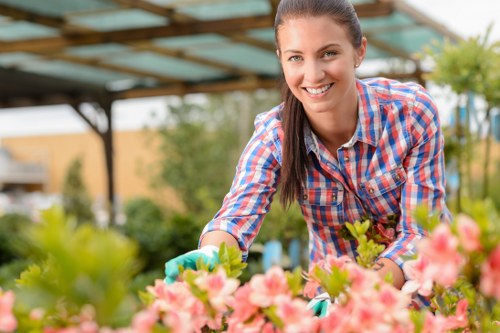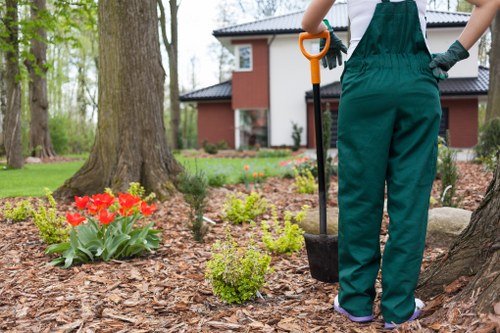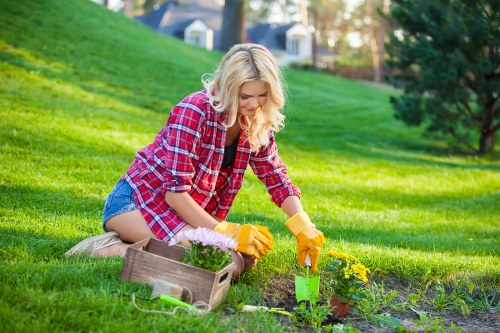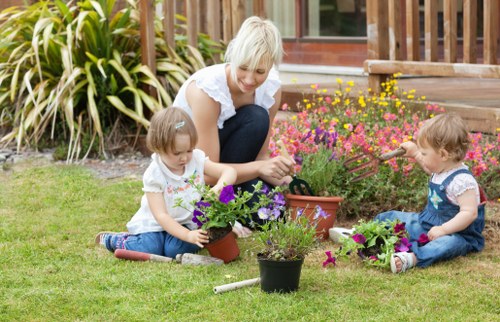Landscape Gardening in Landscape Gardeners

Landscape gardening is an art and science that transforms outdoor spaces into aesthetic and functional environments. Whether you are a seasoned landscape gardener or someone looking to enhance your backyard, understanding the principles and techniques of landscape gardening is essential.
At its core, landscape gardening involves the careful selection and arrangement of plants, structures, and other elements to create a harmonious and sustainable outdoor space. This process not only enhances the beauty of a property but also contributes to its environmental health.
In this article, we will delve into the various aspects of landscape gardening, providing insights and tips for both novice and experienced gardeners. From design principles to plant selection, we've got you covered.

Understanding the Basics of Landscape Gardening
Before embarking on a landscape gardening project, it's crucial to understand the fundamental concepts that underpin successful garden design.
Site Analysis: Assessing the site is the first step in landscape gardening. This involves examining the soil quality, sunlight exposure, drainage, and existing vegetation. A thorough site analysis helps in making informed decisions about plant selection and garden layout.
Design Principles: Incorporating basic design principles such as balance, symmetry, and proportion can significantly impact the overall aesthetic of your garden. These principles help in creating a visually appealing and cohesive space.
- Balance: Ensuring that elements are evenly distributed throughout the garden.
- Symmetry: Creating mirror images on either side of a central axis.
- Proportion: Maintaining harmonious relationships between different elements in the garden.

Choosing the Right Plants
The selection of plants plays a pivotal role in landscape gardening. It not only defines the look and feel of the garden but also influences its maintenance requirements.
Consider factors such as climate, soil type, and sunlight when choosing plants. Native plants are often an excellent choice as they are well-adapted to the local environment and require less maintenance.
Here are some categories to consider:
- Perennials: Plants that live for more than two years, offering consistent beauty.
- Annuals: Plants that complete their life cycle in one year, providing seasonal color.
- Shrubs: Woody plants that add structure and depth to the garden.
- Trees: Essential for providing shade and acting as focal points.

Incorporating Hardscapes
Hardscapes refer to the non-living elements in your garden, such as paths, patios, walls, and decks. These features add functionality and aesthetic appeal, creating defined spaces within the garden.
Pathways: Elegant pathways guide visitors through the garden, enhancing its flow and accessibility.
Water Features: Incorporating water elements like fountains or ponds can add a soothing ambiance to your garden.
- Choosing Materials: Select materials that complement the overall design and are durable.
- Designing Layout: Plan the placement of hardscape elements to ensure they blend seamlessly with the natural surroundings.
- Maintenance: Consider the upkeep required for each hardscape feature to ensure longevity.

Sustainable Landscape Practices
Incorporating sustainable practices in landscape gardening not only benefits the environment but also reduces maintenance efforts and costs.
Water Conservation: Implementing efficient irrigation systems, such as drip irrigation, and selecting drought-resistant plants can significantly reduce water usage.
Soil Health: Maintaining healthy soil through the use of compost, mulch, and organic fertilizers promotes plant growth and resilience.
Additional sustainable practices include:
- Composting: Recycling garden waste to create nutrient-rich compost.
- Rainwater Harvesting: Collecting and storing rainwater for irrigation purposes.
- Native Plant Utilization: Reducing the need for excessive watering and maintenance by choosing native species.

Seasonal Garden Maintenance
Regular maintenance is essential to keep your landscape garden thriving throughout the year. Each season brings its unique set of tasks and challenges.
Spring
Spring is the time for planting new plants, pruning shrubs, and preparing the soil for the growing season. It’s also the perfect time to install new hardscape features if desired.
Summer
During summer, focus on watering, weeding, and managing pests. Ensure that plants receive adequate sunlight and protection from extreme heat.
Autumn
Autumn involves harvesting plants, clearing fallen leaves, and preparing the garden for winter. It’s also a good time to plan for the next year’s garden layout.
Winter
Winter maintenance includes protecting plants from frost, pruning dormant trees, and planning future garden projects. Utilizing mulch can also help insulate plant roots during cold months.

Design Trends in Landscape Gardening
Staying updated with the latest design trends can keep your landscape garden modern and appealing.
Some of the current trends include:
- Vertical Gardens: Maximizing space by growing plants vertically on walls or trellises.
- Minimalist Design: Emphasizing simplicity and clean lines with a focus on essential elements.
- Smart Irrigation: Using technology to create efficient irrigation systems that save water and time.
- Edible Gardens: Integrating vegetables, herbs, and fruit-bearing plants into the garden layout.
Embracing these trends can enhance the functionality and beauty of your garden, making it a delightful space for relaxation and entertainment.

The Role of Lighting in Landscape Gardening
Outdoor lighting is an important aspect of landscape gardening that extends the usability and safety of your garden into the evening hours.
Types of Outdoor Lighting:
- Path Lights: Illuminate walkways and enhance safety.
- Spotlights: Highlight specific garden features or architectural elements.
- String Lights: Create a cozy and inviting atmosphere in seating areas.
- Floodlights: Provide security by illuminating larger areas.
Proper lighting not only accentuates the beauty of your garden but also adds a layer of security and functionality. It's important to choose energy-efficient lighting options, such as LED lights, to minimize energy consumption.

Creating Outdoor Living Spaces
Modern landscape gardening goes beyond plant selection and layout; it encompasses the creation of outdoor living spaces where you can relax, entertain, and enjoy nature.
Some ideas for outdoor living spaces include:
- Outdoor Kitchens: Fully equipped cooking areas that allow you to prepare meals outdoors.
- Fire Pits: Central gathering points for warmth and socializing.
- Seating Areas: Comfortable seating arrangements that blend with the garden's natural elements.
- Gazebos and Pergolas: Structures that provide shade and define spaces within the garden.
By integrating these elements, you can transform your garden into a functional extension of your home, perfect for hosting gatherings or enjoying peaceful solitude.

Hiring a Professional Landscape Gardener
While DIY landscape gardening can be rewarding, hiring a professional landscape gardener can ensure a high-quality and expertly designed garden.
A professional gardener brings extensive knowledge of plant species, design principles, and maintenance techniques. They can help you plan and execute your garden vision, taking into account your specific needs and preferences.
Benefits of hiring a professional include:
- Expertise: Access to professional design and gardening knowledge.
- Time-Saving: Professionals can complete projects more efficiently.
- Sustainable Practices: Implementation of eco-friendly gardening methods.
- Ongoing Maintenance: Regular care to keep your garden thriving year-round.
Investing in a professional landscape gardener can elevate the beauty and functionality of your outdoor space, making it a true reflection of your style and needs.
Conclusion
Landscape gardening is a fulfilling endeavor that combines creativity, nature, and functionality to create beautiful outdoor spaces. Whether you choose to undertake the project yourself or hire a professional, understanding the key principles and practices is essential for success.
By focusing on design principles, plant selection, sustainable practices, and incorporating hardscapes and lighting, you can transform your garden into a serene and inviting environment.
Ready to elevate your outdoor space? Contact us today to start your landscape gardening journey and create the garden of your dreams.
Frequently Asked Questions
1. What is the first step in landscape gardening?
The first step is conducting a thorough site analysis to assess soil quality, sunlight exposure, drainage, and existing vegetation. This information is crucial for effective planning and plant selection.
2. How do I choose the right plants for my garden?
Select plants based on your local climate, soil type, and the amount of sunlight your garden receives. Native plants are often a good choice as they are well-adapted to the local environment.
3. What are the benefits of hiring a professional landscape gardener?
A professional landscape gardener offers expertise in design and plant selection, saves you time, implements sustainable practices, and provides ongoing maintenance to keep your garden thriving.
4. How can I make my garden more sustainable?
Incorporate water conservation techniques, use native plants, maintain healthy soil through composting, and implement rainwater harvesting systems to create a more sustainable garden.
5. What are some popular landscape gardening trends?
Current trends include vertical gardens, minimalist design, smart irrigation systems, and integrating edible plants into the garden layout.
Transform your outdoor living space today with our expert landscape gardening services. Book your service now and let us help you create a garden that reflects your style and enhances your home's beauty.